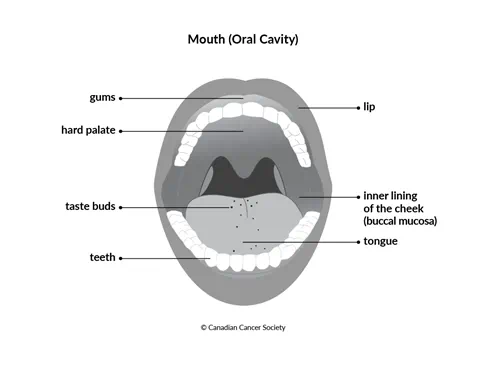What is oral cancer?
Oral cancer starts in the cells of the mouth. A cancerous (malignant) tumour is a group of cancer cells that can grow into nearby tissue and destroy it. The tumour can also spread (metastasize) to other parts of the body. Oral cancer may also be called oral cavity cancer or mouth cancer.
Cells in the mouth sometimes change and no longer grow or behave normally. These changes may lead to non-cancerous (benign) conditions such as warts, fibromas, canker sores and cold sores.
Changes to cells of the mouth can also cause precancerous conditions. This means that the abnormal cells are not yet cancer, but there is a chance that they will become cancer if they aren't treated. The most common precancerous condition of the mouth is oral epithelial dysplasia.
But in some cases, changes to the cells of the mouth can cause oral cancer. Most often, oral cancer starts in thin, flat cells called squamous cells. These cells make up the mucous membrane that lines the mouth (the oral mucosa). This type of cancer is called squamous cell carcinoma (SCC) of the mouth.
Rare types of oral cancer can also develop. These include salivary gland cancer, melanoma and soft tissue sarcoma.
The mouth
The mouth (oral cavity) is part of the digestive system. The lips, cheeks, roof of the mouth (called the hard palate), floor of the mouth and the front part of the tongue (anterior tongue) are all structures within the mouth. They help you speak, taste and chew.

Structure
The mouth begins at the lips. The lips form the outer boundary of the mouth. The inside of the mouth is lined with a thin, moist layer of tissue (a mucous membrane) called the oral mucosa. This inner lining is also sometimes just called the mucosa. The roof of the mouth is formed by the hard palate. The inner surface of the cheeks forms the sides of the mouth (buccal mucosa). The tongue rests on the floor of the mouth (the lowest part of the mouth).

The mouth can be divided into specific areas, including the:
- lips
- anterior tongue (front two-thirds of the tongue)
- floor of the mouth
- inner lining of the cheeks (buccal mucosa)
- hard palate (the bony part at the front of the roof of the mouth formed by part of the upper jawbone)
- gums and alveolar ridge (the ridge-like border of the jaws that contains the sockets of the teeth)
- teeth
The upper jawbone (maxilla) and lower jawbone (mandible) are bones in the face that surround the mouth and support its shape and form.
Function
The mouth has many jobs. It analyzes what you put into it to decide if it is safe to swallow. The mouth is the first step in digesting food. We use our teeth to chew food and break it down into smaller pieces. Chemicals in our saliva help break down starches (carbohydrates). Saliva in the mouth also makes food slippery so it can be swallowed more easily. Taste buds on the tongue tell us what our food tastes like. When chewing and swallowing, the tongue helps move food around in the mouth.
The mouth also helps us:
- speak
- breathe
- drink
- change our facial expressions
Cancerous tumours of the mouth
Precancerous conditions of the mouth
Non-cancerous conditions of the mouth
Your trusted source for accurate cancer information
With support from readers like you, we can continue to provide the highest quality cancer information for over 100 types of cancer.
We’re here to ensure easy access to accurate cancer information for you and the millions of people who visit this website every year. But we can’t do it alone.
Every donation helps fund reliable cancer information, compassionate support services and the most promising research. Please give today because every contribution counts. Thank you.
